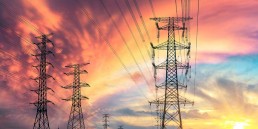Success of Infrastructure Modernization Hinges on Resilient Electric Grid
By John Kyte, strategic director, Protect Our Power
What is the latest buzzword in Washington, D.C.? Infrastructure.
From the White House to Capitol Hill, from federal agencies to the private sector and their lobbyists, everyone is abuzz about rejuvenating and rebuilding our nation’s aging infrastructure.

And it is about time – it is obvious that many of the assets that are essential for the functioning of our society and our economy — roads, bridges, airports, water systems, pipelines, and railroads, to name a few – are in need of repair or replacement.
In fact, in its recently released 2021 Report Card, the American Society of Civil Engineers (ASCE) rated the condition of infrastructure in the United States, assigning a grade of C-minus on an assessment spanning 17 infrastructure categories.
Several infrastructure bills have already been introduced in Congress and a major one is under development at the White House. A common element included in the bills to date has been greater electrification in almost every sector, especially transportation, as well as strong support for greener, cleaner energy sources as a way to reduce our carbon output. These are important initiatives and can help address fundamental energy and environmental concerns.
But missing from much of the talk and legislation, with a few notable exceptions such as DOE Secretary Jennifer Granholm and Rep. Frank Pallone, D-NJ is a clear focus on significantly upgrading the cybersecurity and resiliency of the electric grid – the infrastructure component that powers the rest of our infrastructure network. From manufacturing to providing clean water, from our farms and food supply to our hospitals and healthcare system to our financial networks and the transportation sector, electricity makes it all work.
The electric grid is under daily cyber-assault, as we have been warned about repeatedly by the FBI, the CIA, Homeland Security, and utility companies, and the recent storm-driven debacle in Texas provided a stark illustration of how quickly essential services and supplies disintegrate and disappear without electricity. What happened in Texas cannot be allowed to occur at the national level.
The good news is that modernizing and strengthening our electric grid could produce numerous short- and long-term gains. For example, the continued electrification of transportation — cars, busses, trucks, trains, and someday even airplanes — will require not only more power eventually, but more grid security as well. The widespread and powerful charging networks these vehicles will require could provide pathways for hackers to disrupt the grid and pose unique problems for grid cybersecurity, according to experts and industry officials.
In addition, the continued growth of the Internet of Things, and the full-scale advent of 5G communications capability, also require a more robust electric grid to meet increased energy usage, and a more secure and resilient grid to prevent potentially disabling access through literally billions and billions of interconnected devices and networks.
Prioritizing efforts to make the grid more secure and resilient could also provide a much-needed, job-producing economic boost following the pandemic. The U.S. electrical grid is the largest interconnected machine on Earth, involving approximately 3,000 utility companies, 200,000 miles of high-voltage transmission lines, and 5.5 million miles of local distribution lines, linking thousands of generating plants to factories, homes, and businesses.
While no clear estimate of the cost to upgrade grid security and resiliency has been developed, the sheer size of the effort would likely cause a positive economic impact across the manufacturing, engineering, and construction sectors, as well as along the supply chain and in the utility companies themselves.
Numerous other benefits will result from modernizing the grid, but the most important one is the most obvious — avoiding a major, extended power outage that could be devastating to our economy and our public health and security.
Congressional leadership is critical to jumpstarting a comprehensive program to upgrade the security and resilience of the electric grid. As Congress considers major infrastructure legislation, and local projects assume importance, it is imperative that legislators also keep their eyes on a larger, critically important priority — making our national electric grid more resilient.
John Kyte
Author Bio